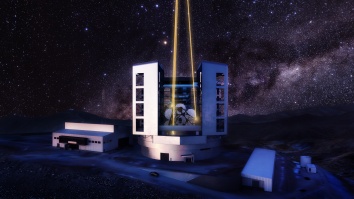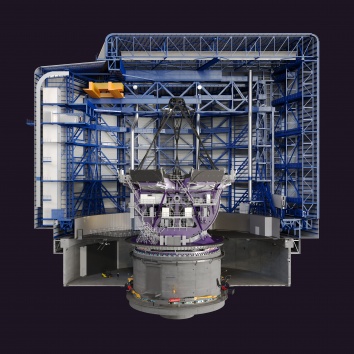Giant Magellan Telescope Awards IDOM Final Design of its Telescope Enclosure
8 March 2022
Renowned engineering and architecture firm, IDOM, faces rigorous design requirements of the Giant Magellan Telescope’s enclosure to allow for unobstructed observations of the night sky.
AUSTIN — The partners of the Giant Magellan Telescope (GMT) today announced they have awarded IDOM, a renowned engineering and architecture firm based in Spain, a contract to complete the telescope enclosure design by 2024. The award follows an extensive enclosure designer evaluation and selection process based on a detailed set of criteria involving design team experience, proposed approaches to specific design challenges, incorporation of safety management in the design process, and more. The University of Texas at Austin is a founding partner of the GMT.
Designing the 4,800 metric ton upper enclosure will be a particularly challenging engineering feat, as it will need to protect the telescope’s giant mirrors from extreme earthquakes and weather, modulate wind speeds and temperatures, and reveal seven of the world’s largest mirrors for unobstructed science observations of the night sky. The enclosure design will also utilize the latest technologies and construction practices to be as sustainable as possible. Once operational in the late 2020s, the Giant Magellan Telescope will produce the sharpest and most detailed images ever taken of our universe — ten times greater than the famed Hubble Space Telescope and four times the James Webb Space Telescope.
“Following an extensive designer evaluation, IDOM proved to have the necessary knowledge, experience, and expertise to solve the design challenges associated with the environmental conditions at the telescope site, especially the local seismic and weather conditions,” said Dr. Bruce Bigelow, the Giant Magellan Telescope’s Site, Enclosure, and Facilities Manager. “Adding the size, functionality, and environmental conditions to the design challenge, efficient manufacturing, especially off-site and modular construction, are key aspects to making the construction of the enclosure safe, reliable, and affordable. We’re delighted to work with IDOM to make the enclosure design a reality.”
Headquartered in Bilbao, Spain, IDOM has 45 offices around the world providing global design solutions for a broad portion of the built environment. Leading the enclosure design is IDOM’s Advanced Design and Analysis group. Their engineers develop special and moveable structures, test systems, instruments and facilities for astronomers, nuclear and particle physicists, and other advanced research fields.
”IDOM is proud to be working on this world-class project. Our multi-discipline team of engineers is well positioned to solve both the technical and practical challenges of this complicated machine,” said Tom Lorentz, IDOM’s President of US Operations. “The IDOM team combines world-class design and construction management experience in large and complex movable structures, with first-hand knowledge of civil and site-specific construction practices and capabilities of the local Chilean contractors.”
IDOM has made remarkable contributions to the design and construction of astronomical facilities, including the development of components for the Gran Telescopio Canarias, the enclosure and thermal systems for the Daniel K. Inouye Solar Telescope, consulting for the Thirty Meter Telescope, design for the Maunakea Spectroscopic Explorer, and the conceptual design for the European Extremely Large Telescope.
Designed for Resilience
The Giant Magellan Telescope’s 65-meter-tall enclosure must overcome two key challenges in protecting its giant mirrors — extreme earthquakes and weather. The Giant Magellan Telescope is being constructed at Las Campanas Observatory in the Chilean Atacama Desert, one of the driest deserts and most seismically active regions in the world. Averaging six earthquakes every month, the site will expose the telescope and enclosure to regular seismic events. The enclosure design provides the telescope pier with a seismic isolation system that can survive the strongest earthquakes expected over the 50-year lifetime of the observatory and will allow the telescope to quickly return to operations after the more frequent, but less intense seismic events that are experienced several times per month. The desert’s extreme weather also requires a robust climate control system to keep high winds and temperature changes from impacting the telescope’s giant mirrors and advanced optical technologies. These automated systems are capable of protecting the telescope from daily temperature swings, to provide an optimal observing environment all night long.
A Focus on Efficiency and Sustainability
Even before the global pandemic created unprecedented supply chain challenges and materials shortages, efficient manufacturing and logistics have remained the priority in the enclosure design process. As such, the enclosure design will use a variety of constructability approaches, utilizing both local materials and a local workforce, to control costs and minimize construction and operational carbon footprints.
IDOM will design the Giant Magellan Telescope’s enclosure to be as sustainable as possible, using the latest technologies and environmental design practices. The construction site currently relies on the Chilean National Electric System, which is predominately supplied by renewable energy. The GMTO Corporation plans to build its own powerline to connect to the Chilean grid, to take advantage of existing renewable energy sources. The completed observatory facilities will employ energy and water efficient technologies, including a greywater treatment and recovery systems to significantly reduce water usage.
IDOM is a privately held, global engineering, architecture, and consulting firm, with more than 4,000 employees and 45 offices around the world, including US locations in Minneapolis and Atlanta and headquarters in Bilbao, Spain. To learn more about IDOM, visit https://www.idom.com/en.
The Giant Magellan Telescope is the work of an international consortium of leading universities and research institutions representing five countries. To learn more, visit https://www.gmto.org.
— END —
Media Contacts:
Rebecca Johnson, Communications Manager
McDonald Observatory
The University of Texas at Austin
(512) 475-6763
Ryan Kallabis, Director of Communications
Giant Magellan Telescope
(626) 204-0554
Amaia Oyón Blanco, Communications Officer
IDOM
+34 943 40 06 02







